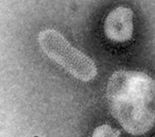By Dr. Roman Pogranichniy, DVM, Ph.D.
Swine influenza A virus (IAV) was first recognized clinically in pigs in the Mid-western U.S. in summer/fall of 1918, which coincided with the human influenza pandemic known as the Spanish flu. The etiology of SIV was confirmed by the first isolation of IAV in 1930. Since then IAV has been of significant importance to the swine industry throughout the world.
 At the ADDL, we have been conducting diagnoses of swine influenza virus for many years. By using new and advanced diagnostic techniques, we can diagnose several types of the influenza virus in the population rapidly and accurately allowing decisions to be made in the field for treatment or prevention of the disease. Since 2004 The Indiana ADDL has been part of the National Animal Health Laboratory Network, and has participated in different surveillance programs established by USDA/NAHLN. Currently we are doing an anonymous surveillance program for IAV to monitor the influenza virus in the field. This program has the following objectives:
At the ADDL, we have been conducting diagnoses of swine influenza virus for many years. By using new and advanced diagnostic techniques, we can diagnose several types of the influenza virus in the population rapidly and accurately allowing decisions to be made in the field for treatment or prevention of the disease. Since 2004 The Indiana ADDL has been part of the National Animal Health Laboratory Network, and has participated in different surveillance programs established by USDA/NAHLN. Currently we are doing an anonymous surveillance program for IAV to monitor the influenza virus in the field. This program has the following objectives:
- Monitor genetic evolution of IAV to better understand endemic and emerging influenza virus ecology.
- Make available SIV isolates for research and establish an objective database for genetic analysis of these isolates and related information.
- Select proper isolates for the development of relevant diagnostic reagents, updating diagnostic assays, and vaccine seed stock products.
This influenza surveillance program is supported by the American Association of Swine Veterinarians and many swine veterinarians in Indiana and across the country. Some publications and comments can be found on the AASV website: http://www.aasv.org/shap/issues/v20n6/v20n6advocacy.html
We would like to cite Dr. Snelson (AASV Director of Communications) about the importance of the influenza virus surveillance program in US.
“This experience highlights the importance of United States Department of Agriculture’s (USDA’s) Swine Influenza A Virus (IAV) Surveillance Program. This voluntary program was implemented to monitor influenza viruses in the US swine herd and provide viral isolates to animal-health and public-health officials for research and vaccine development. The overarching objective of the program is to better protect public and animal health. Analysis of test results can provide some insight into influenza virus activity in swine samples submitted to veterinary diagnostic laboratories.”
Since June, 2012 the ADDL has tested more than 305 samples for influenza virus and provided information to NAHLN as part of the anonymous program in Indiana. This included tests by PCR for detection and typing of influenza virus in the samples within 24-72 hours, as well as virus isolation and sequencing of 3 viral genes of the influenza virus.
All testing done in the ADDL as part of the IAV surveillance program is paid for by NAHLN unless the submitting veterinarian requests to be removed from the surveillance program in which case standard fees apply. To date, all samples submitted to the ADDL enrolled in the voluntary USDA IAV surveillance program.